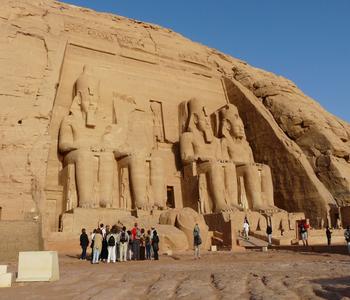PeopleEgypt is the Middle East's most-populous country, with an estimated 83 million people, and the African continent's third most populated region. 98% of the inhabitants are Egyptian, leaving the other 2% to several minorities, including the ancient Nubian communities that live along the Nile River, the Bedouin Arab tribes, who mainly populate the eastern desert areas, and the Siwis located in the Siwa Oasis. A few other minorities include the tribal communities of Beja, who are mainly in the southeastern part of Egypt, and the Dom clans in Faiyum and the Nile Delta.
|
Egypt covers roughly 390,000 square miles of both North Africa and western Asia. The majority of the country is in North Africa, with only the Sinai Peninsula occupying Asia. To the north of Egypt is the Mediterranean Sea, with the Red Sea to the east, Sudan to the south, and Libya to the west. The ancient civilization of Egypt makes this country fascinating, as do the well-known monuments, including the Great Sphinx and the Giza pyramid complex. Many ancient artifacts such as the Valley of the Kings and the Karnak Temple are in the area of Luxor, in the southern part of the country. The economy of Egypt is one of the most developed in the Middle East, with agriculture, industry, and tourism leading the way. Due to the several ancient artifacts and structures, the tourism is well established and growing quite rapidly. |
Geography
Egypt is a very large country, but 99% of the population uses only 5.5% of the land area, due primarily to Egypt's very dry climate. Other than the Nile Valley portion of Egypt, the country's landscape is a desert. Parts of both the Libyan and the Saharan deserts are located in Egypt, with sand dunes reaching as tall as one hundred feet. Due to the desert climate of the country, there is not much rainfall, and temperatures can reach as high as 109 degrees Fahrenheit in the summer and as low as 55 degrees Fahrenheit in the winter.
HistoryThe history of Egypt is separated into several periods according to the pharaoh in power at the time. The Predynastic Period was prior to 3100 BC, followed by the Protodynastic Period from 3100 to 3000 BC. The Early Dynastic Period included the First and Second Dynasties. During the Old Kingdom era the country was ruled by the Third, Fourth, Fifth and Sixth Dynasties. The Seventh through the Eleventh Dynasties ruled Egypt during the First Intermediate Period, and the Twelfth and Thirteenth Dynasties ruled The Middle Kingdom. The Fourteenth through the Seventeenth Dynasties ruled the Second Intermediate Period, while the period of the New Kingdom was ruled by the Eighteenth through the Twentieth Dynasties. The Third Intermediate Period was ruled by the Twenty First through the Twenty Fifth Dynasties, and the Late Period was ruled by the Twenty Sixth through the Thirty First Dynasties. These many divisions help Egyptologists to focus on specific periods of Egypt's long history.
|
Famous Attraction
The Pyramids of Giza and the Sphinx are perhaps the most famous tourist spots in Egypt are. These pyramids are a testament to the architectural accomplishments of ancient man. The Pyramid of Giza is the only surviving wonder of the Seven Wonders of the World. Carved from a single block of stone, the Sphinx lies just in front of the Giza Pyramid and is known as "Father of Terror". Another great tourist attraction is Medieval Cairo. This section of the city is full of life and activity, with churches, mosques and bazaars. The Temples of Karnak are built on a plot of land that measures 1500 by 800 meters, ancient Egypt's most important place of worship for at least two thousand years. One part of the Temples of particular interest is the Hypostile Hall, in the Great Temple of Amun.
NightlifeThe nightlife of Egypt is very active with many interesting bars and nightclubs, playing all types of music, and providing fun games that patrons can take part in. Several of the hotels have nightclubs in them as well, so it's convenient for those who prefer to stick close to their hotel room and still enjoy a night of dancing and fun. A great way to see the city of Luxor is to take a horse drawn carriage ride at night, when the city is lit up and beautiful to see on a cool evening.
|
Culture
Standard Arabic is the official language of Egypt and the written media typically use this language, but the more commonly spoken language of the country is Egyptian Arabic. People in the business world, or the more educated areas of Egypt, also speak French and English. Many parts of Egyptian social life are controlled by religion. The country's most predominant religion is Muslim, with about 80% to 90% of the population, and of that percentage, most belong to the Sunni Islam. The other 10% of the population are a part of the orthodox branch of Christianity known as the native Coptic Orthodox Church of Alexandria.
CuisineEgyptian cuisine uses a lot of vegetables and legumes in its dishes. The national dish of Egypt is Kushari, a combination of lentils, rice, and macaroni. Fava beans are another popular ingredient in Egyptian cooking, and bread is served with every meal. This has been a tradition all the way to the beginning of the history of Egypt. Pita bread is used as a scoop for hummus and other dips, and it is also used to make gyros, falafel and to wrap kabobs. Aish Merahrah, Egyptian bread, is a traditional staple of the Egyptian diet, served on the side at any meal. During Ramadan, Muslims eat only before sunrise and after sunset, and at this time particular attention is placed on the richness and variety of food. Families gather at sunset to break the fast together and enjoy a feast of delicious food and desserts.
|
Qunar







